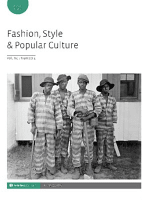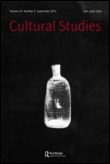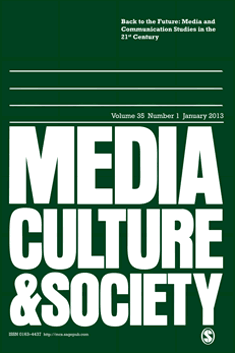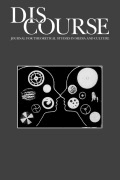
JOURNAL OF POPULAR CULTURE
Scope & Guideline
Diving Deep into the Heart of Popular Culture
Introduction
Aims and Scopes
- Interdisciplinary Analysis of Popular Culture:
The journal emphasizes the integration of various disciplines to analyze popular culture phenomena, encouraging contributions that draw from sociology, media studies, literature, and cultural theory. - Focus on Representation and Identity:
A strong emphasis is placed on issues of representation across race, gender, and sexuality, examining how popular culture reflects and shapes societal identities and power dynamics. - Cultural Critique and Historical Contextualization:
The journal frequently engages in critical examinations of historical contexts surrounding popular culture, analyzing how past events influence contemporary cultural expressions. - Exploration of New Media and Digital Cultures:
The journal includes discussions around the impact of digital media and technologies on culture, including social media, video games, and streaming services. - Engagement with Global Perspectives:
There is a consistent focus on global popular culture, exploring how cultural practices and media from different regions interact and contribute to a larger global discourse.
Trending and Emerging
- Digital Culture and Social Media Impact:
There is a notable increase in research exploring the influence of social media and digital platforms on cultural production and identity formation, reflecting the contemporary media landscape. - Intersectional Analyses of Identity:
Emerging themes increasingly emphasize intersectionality, examining how overlapping identities (race, gender, sexuality) shape experiences and representations in popular culture. - Activism and Social Justice in Media:
Papers focusing on the role of popular culture in social justice movements and activism are gaining traction, highlighting how media can influence societal change. - Transmedia Narratives and Content Creation:
The rise of transmedia storytelling is a significant trend, with scholarly work exploring how narratives extend across various media platforms and engage audiences in innovative ways. - Globalization and Cultural Exchange:
A growing interest in the globalization of popular culture is evident, with research exploring the exchange of cultural practices and the impact of globalization on local identities.
Declining or Waning
- Traditional Media Analysis:
There appears to be a decrease in papers focusing solely on traditional media formats, such as print media, as the journal shifts towards exploring digital and new media landscapes. - Nostalgia Studies:
Though nostalgia remains a relevant theme, papers explicitly centered on nostalgia-driven cultural analysis have become less frequent, possibly due to the evolving nature of cultural consumption. - Simplistic Genre Studies:
Research that simplifies genres without deeper contextual analysis is declining, as the journal increasingly favors complex, interdisciplinary approaches that challenge traditional genre boundaries. - Historical Representation without Contemporary Relevance:
Papers that focus solely on historical representations in popular culture, without connecting them to contemporary issues, are becoming less common. - Focus on Domestic US Culture:
The journal is gradually moving away from a narrow focus on domestic popular culture in the U.S., incorporating more global perspectives and intercultural analyses.
Similar Journals

HISTORY OF PHOTOGRAPHY
Capturing Time: The Art and Evolution of PhotographyHISTORY OF PHOTOGRAPHY is a prestigious scholarly journal published by Taylor & Francis Ltd, focusing on the rich and evolving narrative of photography as an art form and cultural phenomenon. With an ISSN of 0308-7298 and E-ISSN 2150-7295, this journal has established a significant presence since its inception in 1977, with an anticipated run into 2024. Positioned in the Q4 category of the Visual Arts and Performing Arts field, it ranks within the 51st percentile among its peers, affirming its role in the scholarly discourse of photography. Although not an Open Access journal, it maintains accessibility for academics through institutional subscriptions and various library networks. The journal aims to foster interdisciplinary dialogue, encompassing diverse perspectives on the history, theory, and practice of photography, making it an invaluable resource for researchers, professionals, and students alike who are seeking to deepen their understanding of this dynamic medium.

Fashion Style & Popular Culture
Exploring the Threads of Culture and IdentityFashion Style & Popular Culture is a pioneering journal that explores the dynamic interplay between fashion and societal trends within a diverse cultural context. Published by INTELLECT LTD in the United Kingdom, this journal serves as a vital resource for researchers, professionals, and students engaged in fields such as cultural studies, marketing, and social psychology. With an ISSN of 2050-0726 and an E-ISSN of 2050-0734, it provides a robust forum for scholarly discourse, examining the influence of fashion on identity formation, popular culture, and contemporary social practices. Despite not being open access, its esteemed rankings across various quartiles highlight its relevance, particularly in the category of Cultural Studies, where it proudly holds a Q2 status as of 2023. The journal's significance is underscored by its commitment to multidisciplinary research and analysis, inviting contributions that enhance our understanding of material culture and its ramifications on everyday life. As it converges from 2016 to 2024, Fashion Style & Popular Culture continues to cultivate a rich academic dialogue that bridges theoretical insights with practical implications in an ever-evolving cultural landscape.

CULTURAL STUDIES
Engaging with the Latest Theoretical FrameworksCULTURAL STUDIES, published by Routledge Journals, Taylor & Francis Ltd, is a prestigious academic journal dedicated to the exploration and analysis of cultural phenomena across diverse contexts. With an ISSN of 0950-2386 and an E-ISSN of 1466-4348, this journal has established itself as a leading platform for scholars, researchers, and practitioners interested in the intersections of culture, identity, and society. Since its inception, CULTURAL STUDIES has transitioned through several converged years of publication, currently producing cutting-edge research that reflects its strong positions in Q1 quartiles across multiple disciplines, including Anthropology, Social Sciences, and Arts and Humanities. With an impressive Scopus rank of 75/1304 in Cultural Studies, the journal is an essential resource for those seeking to engage with the latest theoretical frameworks and methodologies in understanding cultural dynamics. Although it is not currently open access, CULTURAL STUDIES remains a critical vessel for disseminating knowledge that impacts both academic and practical applications in cultural analysis. For scholars and students eager to contribute to this vibrant field, the journal serves not only as a repository of knowledge but also as an inspiration for further inquiry into the complexities of culture.

Chinese Literature and Thought Today
Connecting Ideas: The Intersection of Literature and Philosophy in ChinaChinese Literature and Thought Today is a dynamic academic journal dedicated to the exploration of contemporary Chinese literary and philosophical discourse. Published by Routledge Journals, Taylor & Francis Ltd, this journal aims to provide a platform for the dissemination of innovative research and critical analysis in the fields of literature and philosophy, focusing on the evolving dynamics of Chinese culture within a global context. With an ISSN of 2768-3524 and an E-ISSN of 2768-3532, it is committed to Open Access principles, ensuring that valuable insights are readily accessible to researchers and practitioners alike. Although it is currently positioned in the Q4 tier across various categories including Arts and Humanities and Literature and Literary Theory, the journal's nascent status promises a growing repository of knowledge that invites contributions aimed at provoking thoughtful dialogue in these interdisciplinary studies. As it converges over the years from 2022 to 2024, it offers an essential resource for anyone interested in the intersections of literature, thought, and culture in contemporary Chinese society.

SCHWEIZERISCHES ARCHIV FUR VOLKSKUNDE
Exploring the Rich Tapestry of Folk CultureSCHWEIZERISCHES ARCHIV FUR VOLKSKUNDE, with ISSN 0036-794X, is a vital resource for scholars and practitioners in the fields of Arts and Humanities and Cultural Studies. Published by G KREBS VERLAGSBUCHHANDLUNG AG in Switzerland, this journal plays a crucial role in advancing the discourse surrounding folk culture, traditions, and anthropology. Despite its current ranking in the Q4 category for both Arts and Humanities and Cultural Studies, the journal serves as an essential platform for disseminating unique research findings and insights, contributing to a well-rounded understanding of diverse cultural practices. Researchers, professionals, and students are encouraged to explore the rich content produced between 2008 and 2014, and from 2017 to 2023, which reflects a commitment to fostering a multidisciplinary approach to folklore studies. By addressing the complexities of cultural dynamics, the journal not only promotes scholarly engagement but also enriches the academic community’s appreciation of folk traditions.

POETICS
Fostering Dialogue Through Cutting-Edge ResearchPOETICS is a leading academic journal published by Elsevier, focusing on the multidisciplinary fields of Communication, Cultural Studies, Linguistics, Literature and Literary Theory, and Sociology and Political Science. With its esteemed Q1 category rankings across several domains, POETICS showcases cutting-edge research that fosters dialogue and innovation within the arts and social sciences. The journal's commitment to advancing theoretical and empirical understanding of the dynamics between language, culture, and society is evidenced by its impressive Scopus rankings, placing it in the top percentiles among its peers. Covering a wide array of topics, from narrative theory to sociolinguistic analysis, POETICS serves as an indispensable resource for researchers, academics, and students eager to explore the intersection of literature and societal discourse. Situated in the Netherlands, the journal benefits from a rich tradition of scholarly excellence and aims to contribute significantly to the evolving landscape of contemporary research through its ongoing publications until 2024.

Journal of Asia-Pacific Pop Culture
Fostering Insight into Global Cultural Phenomena from Asia-PacificJournal of Asia-Pacific Pop Culture, published by Penn State University Press, serves as a pivotal platform for scholarly discourse surrounding the dynamic cultural landscapes of the Asia-Pacific region. With its ISSN 2380-7679 and E-ISSN 2380-7687, this journal aims to explore the complex interplay between popular culture, media, and society, providing insight into contemporary trends, practices, and the global implications of cultural phenomena. Although currently not an open-access journal, the Journal of Asia-Pacific Pop Culture encourages the contribution of researchers, scholars, and students interested in traversing the vast narratives found within this vibrant field. As it endeavors to foster the understanding of cultural identities and transformations across this diverse region, the journal positions itself as an essential resource for academic exploration and professional engagement in cultural studies.

MEDIA CULTURE & SOCIETY
Exploring the Intersections of Media and Cultural DynamicsMEDIA CULTURE & SOCIETY, published by SAGE PUBLICATIONS LTD, is a prominent academic journal dedicated to the interdisciplinary exploration of media, culture, and societal dynamics. With a long-standing history since its inception in 1979 and extending to 2024, this journal serves as a vital platform for researchers, professionals, and students interested in understanding the complex interplay between media and cultural phenomena. Operating from the United Kingdom, it holds a prestigious Q1 ranking in both communication and sociology/political science categories, reflecting its significant impact within these fields. The journal’s Scopus ranks further attest to its excellence, placing it in the top percentiles and making it an essential resource for advancing scholarly discussions. While not open access, MEDIA CULTURE & SOCIETY continues to provide insightful analyses that shape contemporary discourse on the role of media in society, ensuring its relevance and importance to academic communities worldwide.

Discourse-Journal for Theoretical Studies in Media and Culture
Innovating perspectives on contemporary media challenges.Discourse: Journal for Theoretical Studies in Media and Culture, published by Wayne State University Press, serves as a vital academic platform dedicated to advancing the theories and critical discussions surrounding the complex interplay of media, culture, and society. With an ISSN of 1522-5321 and an E-ISSN of 1536-1810, this journal aims to foster interdisciplinary dialogue among researchers, professionals, and students alike. Although not an open-access journal, it provides a wealth of peer-reviewed articles that delve into contemporary issues in media theory and cultural studies, reflective of its commitment to intellectual rigor and scholarly excellence. With its emphasis on innovative perspectives and critical analysis, Discourse is essential for anyone engaged in exploring the implications of media in our cultural landscape, making it a pivotal resource in the field.

Italianist
Advancing Knowledge in Italian Culture and AnthropologyItalianist is a distinguished peer-reviewed journal published by Routledge Journals, Taylor & Francis Ltd, focusing on the multifaceted aspects of Italian culture, history, and anthropology. With a proud history spanning from 1981 to 2001 and then again from 2003 to 2024, this journal caters to a global audience of scholars, professionals, and students seeking to deepen their understanding of Italian studies. Although it currently operates without an open access option, it provides invaluable insights that contribute to critical discourse in the field, evidenced by its rankings in Scopus: Q4 in Anthropology and Q3 in History, demonstrating its growing influence among academics. The journal is based in the United Kingdom and strives to promote high-quality research that explores historical narratives, cultural practices, and anthropological themes related to Italy, making it an essential resource for anyone interested in this rich and vibrant area of study.